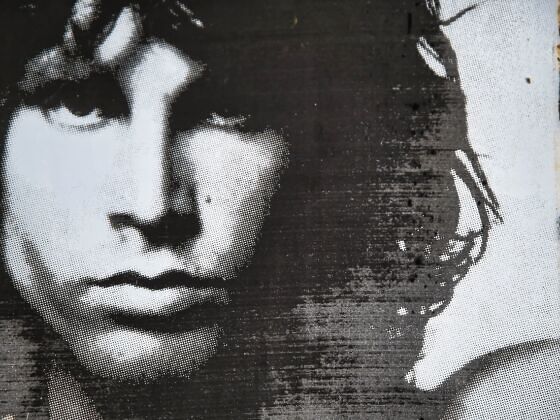I was standing in a crowd of people after a music festival in Mexico City when I saw a guy with a goatee and horn-rimmed glasses handing out flyers. That guy must really like Johnny Depp, I thought. I looked at the flyer. It advertised a concert by a Doors tribute band, MCed by the guy handing out flyers. He was a Johnny Depp impersonator, and was going to read Lawrence Ferlinghetti poems between songs.

Doors and Beats: Strange Pillars of American Culture in Mexico
It was around this time that I realized that for a certain significant population of Mexican males, the writings of the Beat Generation and the music of the Doors represented the apex of American culture.
Their numbers may have been small, but I saw their signs everywhere. At party after party, slacker / hipster dudes asked me if I liked Kerouac or Ginsberg while “Soul Kitchen” played on the stereo. From a bus leaving the Observatorio depot, I spotted “Krieger-Manzarek” spray-painted in huge letters on a concrete highway barrier. Even at the dirtiest, poorest-looking small-town bar I went to in Mexico, where old men in white cowboy hats sat and smoked by the saloon doors and no women were allowed, after a full set of banda ballads someone put “Riders on the Storm” on the jukebox.
A young poet who took two English classes with me wanted to discuss the novels of John Fante. I’d never heard of the author before, but it soon came out that the poet was mainly interested in Fante because of his association with the Beats. At the Chopo flea market, a Doors tribute band played loudly and badly on a big stage, the Jim Morrison guy shielded against the midday heat by the force of his impersonation and his leather pants.
At first I was puzzled by this fixation on Burroughs and “Roadhouse Blues.” Among people in New York who profess to read important novels, the Beats are usually something you’re supposed to get over after high school. The Doors loved the Beats, of course — as did so many ‘60s rockers — and as with the Beats, you were expected to grow out of their theatrical hedonism on your way to appreciating “serious” music.
I decided cultural immaturity was a bad explanation for this phenomenon, and looked to the past. The history of US-Mexican relations often looks like a timeline of American seizures of territory, exploitative trade policies, and unexamined racism when viewed from south of the border. By contrast, the Beat Generation might represent a high point in the interaction between the two countries. After all, Kerouac, Burroughs, and Ginsberg loved Mexico and spent long stretches in Mexico City and Cuernavaca. In On the Road, Sal calls rural Mexico “the golden land that Jesus came from,” and sees in the eyes of the locals his Beatific ideal. The Beats “got” something about Mexico that other American writers didn’t.
I still couldn’t figure out the Doors thing, though. Some claim that rumors of Jim Morrison taking mushrooms in Hidalgo and being photographed with a native necklace inspired Mexican hippies to examine their indigenous roots. But there’s an even more important factor: It seems that between 1960 and the end of the 1980s, only two major English-language rock groups performed in Mexico: First was the Byrds, in a riotous, inaudible stadium show in March 1969. Three months later, the Doors came.
They were originally scheduled to play a concert for the masses in Mexico City’s plaza de toros, but the mayor conveniently took a trip to the Soviet Union when he was supposed to sign the entertainment permit. They ended up playing at an exclusive dinner club, where the children of the elite timidly watched the rocanrol. Outside, though, in the torrents of the rainy season, thousands of ordinary Mexicans crowded the pavement to catch a bit of “Light My Fire.”